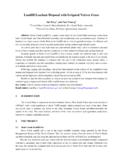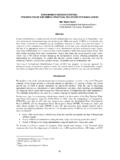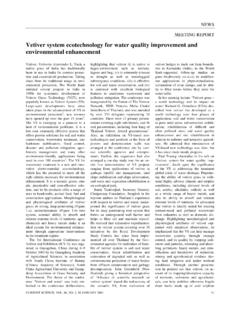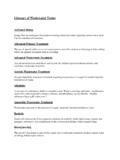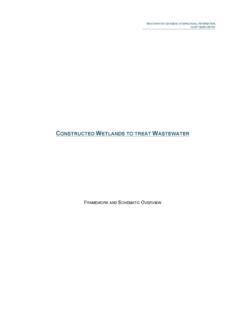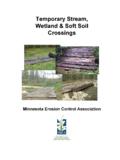Transcription of Potential Role for the Vetiver System in Gulf Coast ...
1 Vetiver Grass roots showing the differencebetween the infertile, non-invasive Vetiveria zizanioides(long root System ) and a native variety to SE Asia,(short roots), after 12 months of Role for the Vetiver System in Gulf Coast Infrastructure Protection and wetland StabilizationThe Vetiver System is an effective, low cost bioengineering technology that strengthensinfrastructure protection and marsh replenishment by reliably enhancing control over soiland water management. Vetiver is a uniquely dense, erect, deeply rooted clump grass long planted around the Gulf Coast -- that is non fertile and non invasive. The conceptbehind the System is planting Vetiver (Vetiveria zizanioides = Chrysopgon zizanioides) ingeometric or natural patterns (such as chevrons or contours) that reinforce the dynamicprocesses of flow and deposition. Global experience, including Hurricane Mitch in 1998 inCentral America, confirms the ability of the Vetiver System to protect vital infrastructure inthe face of extreme weather events: Severalapplications of the Vetiver System are relevant for planning recovery from the currenthurricane damage in the Gulf of Mexico region, and for preparing mitigation strategies inanticipation of the future.
2 A current summary of the Vetiver System was presented at theInternational Soil Conservation Conference held in Brisbane, Australia in 2004: hedges above mangroveferns on river dike in VietnamThe Vetiver Network (TVN) is an international nonprofit 501(c)(3), non-government organization chartered in thestate of Virginia, USA. Since 1989, TVN s mission has been to support research on Vetiver grass and its manyapplications, to document Vetiver uses, and to disseminate that information widely through its and through more than forty affiliated national level Vetiver networks. In recent years, TVN hasexpanded its scope of activity to include applying the Vetiver System (VS) to specific problem areas. Technicaladvisors are available from TVN to assist in project design and implementation. Additional information isavailable by contacting TVN. Contact information for Louisiana and Mississippi scientists familiar with Vetiver isalso available on requestRecommendation for Vetiver hedgeson levees is for the waterside leveewall to be planted every m.
3 To 1 and on the land side from 1-2m. elevation. Additional cross rows onthe waterside wall at about 2-3 at right angles to the flowdirection. The interval between crossrows varies with expected flow grass has specialcharacteristics that lend themselvesto protection of infrastructure andwetlands: Stiff, erect stems enable ahedge to stand up to highvelocity water flows andprevent scouring of the soil; The high density of theleaves and stems forms aporous barrier that traps fineand coarse sediments; Fine, dense, penetratingroots anchor the soil profileup to four meters; High tolerance to salinity(50% yield reduction at 20dS/m and maximum of 45dS/m) facilitates its use toprotect coastal sand dunesand beaches and barrierislands against storm surges; Perennial hedges have anunlimited lifetime with simplebasic maintenance; It is a native to wetlands andthe hedges can be used toestablish vegetative barriersin marshlands capturingsediment to rebuild land.
4 And Its non-invasiveness insuresthat it stays where it isplanted and nowhere protection: Contour hedges of Vetiver grass protect levees againstsoil erosion from wave action and lateral water movement and will protect theland side of the levee from scouring and breaching during an episode of overtopping from a storm surge. How does Vetiver do all this? By increasing theshear strength of the soil up to 40% with Vetiver s massive root System thatcannot be dislodged by moving water and by nailing the upper 3 m. of soil inplace. The effect is to increase the levee safety factor significantly. Dr. PaulTruong's report documents the use of the Vetiver System for dike stabilizationon the Mekong to: "vetivert" (Khus Khus, the "original scent of New Orleans") is awell-known, domesticated pan-tropical grass that has been a heritage plantof Louisiana culture for 200 years.
5 Vetiver roots have an average tensilestrength of 75 Mpa, which increases the shear strength of soil between 30and 40%. Vetiver grass, a hydrophyte with deep roots that do not tiller to theside, is drought and of civil works: Vetiver grass planted at the interface betweensoil, concrete such as culverts, bridge structures and moving water, supportsand drains, will prevent undermining and loss of structural integrity. Afteryears of testing the ministries of transportation of five southern Chineseprovinces have standardized on the Vetiver System to substitute for moreexpensive conventional civil works, such as bench terracing, gabions, and riprap for road infrastructure. In Madagascar the Vetiver System made itpossible for the third steepest railroad in the world to survive regularcyclones without significant interruption and to operate year round. stabilization, and beach and dune stabilization: Vetiver grass isat home in a marsh environment and grows in littoral areas, including eitherdry or saturated soils, surviving months of inundation in fresh or brackishwaters.
6 Eroding barrier islands and brackish marshes can be protected bysystematic Vetiver hedge plantings. Vetiver hedges can stabilize earthenstructures designed to intercept and precipitate sediment, acting as a pioneerplant that helps native marsh plants become established and giving way tothose plants over time. The documentation concerning stabilizing dunes inVietnam is provided at: Vetiver hedge profile after 30 to the left of the hedge and one cansee more than 40 cm. of soil trappedbehind the hedge. The original soil level isindicated by the black subsoil band andthe original plant was planted where thewhite marker is. The hedge width is about60 embankment protectionFour meter roots keep soil wall in placePermanent waterway embankment with vetiverSpecial characteristics of Vetiver GrassWhat makes Vetiver grass special? The answer is found in the roots, in the plant s physiological and ecologicalcharacteristics, and in its inherent ability to grow without becoming a weed and without attracting grass has a massive, finely structured root System that is unique among grasses.
7 With no rhizomes or stolonsthat spread to the sides, the plant s roots grow straight down as a mass as dense as the amount of leaves it producesabove the ground. These roots penetrate 3 to 4 meters into the soil before slowly thinning out; but in one case inThailand, they were found to reach a depth of 6 meters. New roots and shoots develop from the root crown and nodeswhen the plant is buried by trapped sediment at the face of a contour hedge. The plant will continue to grow and fill in atthe surface level, with the new ground level eventually forming a terrace behind the has special characteristics with respect to waste and wastewater management as well. It has a very high tolerance toanoxic environments and high concentration of toxic substances such as heavy metals and ammonia that kill most allother plants. Vetiver grass may be used in constructed wetlands to polish pre-treated wastewater effluents or ashedges to intercept and treat highly toxic leachates from landfills or brownfields characteristicsVetiver grass is a climax plant, which survives conditions under which other plants cannot live.
8 It will tolerate prolongeddrought, fire, flood, submergence, and extreme temperatures from -15 C to 55 C (in Australia) and higher (in India andAfrica). In some cases it may be the only plant to survive. Its ability to regrow quickly after being affected by drought andespecially by fire, as well as by frost, salt, and other adverse soil conditions, and is unequalled by other can withstand a wide range of pH growing in soils with an acidity of and can survive in alkalinities with a pH as highas to 11. Vetiver can tolerate a high level of soil salinity, soil sodicity, and acid sulfate, making it a unique plantunder these conditions.'Sunshine' Vetiver is a traditional, non-fertile variety with a 200 year history in Louisiana that is propagated vegetativelybecause it does not produce viable seeds. It was officially released from observation by the Plant Material Center inGolden Meadow, Louisiana in 1995.
9 Refer to The SouthEastern Exotic Pest Plant Council, declared in May 2001 that Sunshine Vetiver is acceptable, , non-invasive, for usein the southeastern region of the US. Refer to: also or contact Mark Dafforn at for characteristicsBecause of its previously stated qualities, Vetiver grass can be considered as a nurse plant on wastelands or disturbedlands. Planted as a hedge, or as a series of hedges, Vetiver stabilizes the erodible ground (particularly steep slopes) as itcreates a micro-climate so other plants have a chance to establish themselves. The Vetiver System is used successfullyto rehabilitate mine sites and stabilize highway and railway embankments, bridges, and even in rock the trees and shrubs have established on these sites, they begin to shade the Vetiver hedge out, replacing it as thestabilizing agent. Therefore, Vetiver is highly regarded as a non-intrusive land rehabilitation pioneer, though 'crowded out'it remains intact.
10 It is a general principle that plants intended for use in environmental protection or agriculture beinvestigated for their Potential to become weeds or intermediate hosts for pests that affect economically important the few seeds that Vetiver grass produces are not viable and the absence of pests that affect it, the plant hasbeen approved for use in the southeastern US as previously Role for the Vetiver Systemin Gulf Coast Infrastructure Protectionand wetland StabilizationThis image shows the massiveroot zone of an 18 month oldclump of Vetiver grass fromSouthern China. Notice that theroots are fibrous, vertical innature, and without the presenceof lateral leaves and stems have beencut off the top. The clump itself iscomposed of several hundredindividual slips or sprigs that growtogether to make up the planted in hedges along thecontour of slopes, this massiveunderground root zone createsvertical walls as deep as four is not invasive, has non-fertileseeds, and does not have lateralroots.


